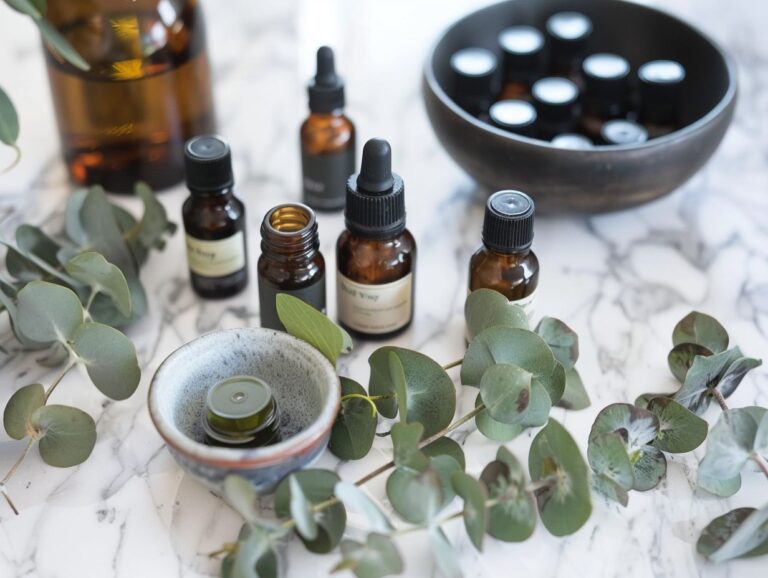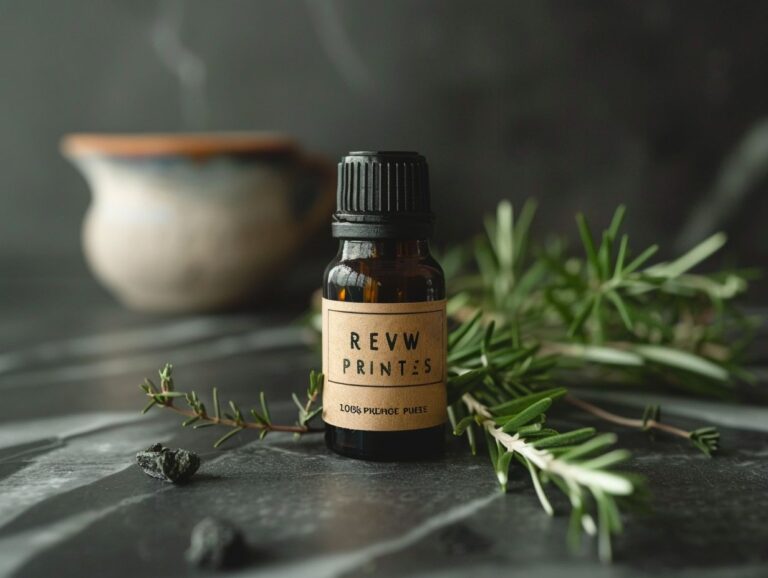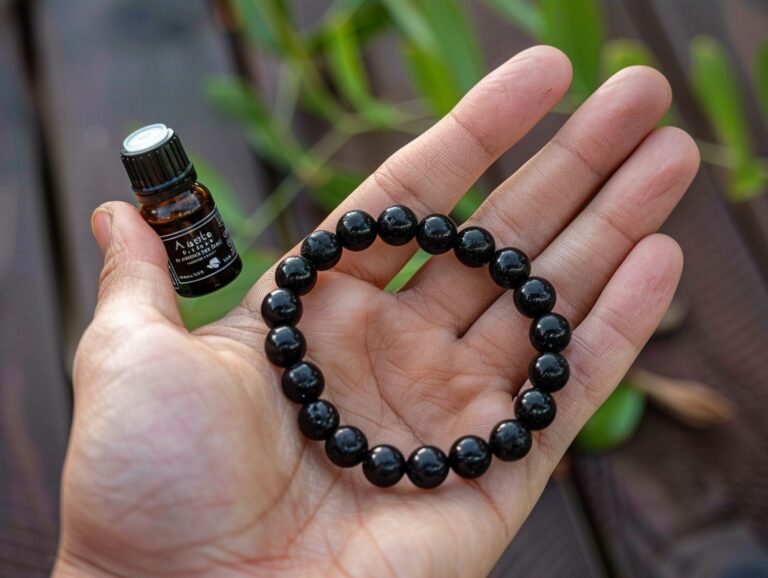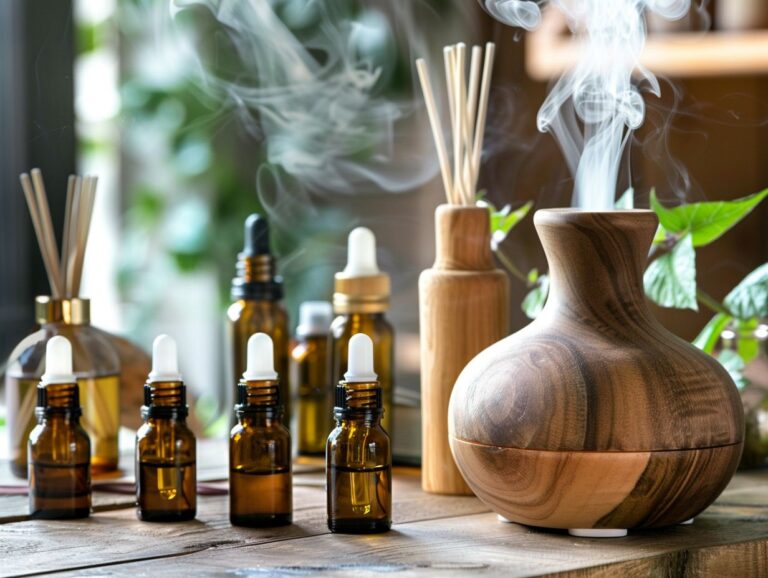How Are Essential Oils Extracted
Essential oils have become a popular ingredient in many skincare products, cleaning supplies, and even medicinal treatments.
But have you ever wondered how these oils are actually made? We will explore the various methods used to extract essential oils, including steam distillation, cold pressing, and solvent extraction.
Delve into the different types of essential oils, their uses in aromatherapy, skincare, and more. Sit back, relax, and prepare to be enlightened about the world of essential oils.
Key Takeaways:
What Are Essential Oils?
Essential oils are natural oils typically obtained through the distillation of aromatic plants and contain the essence of the plant’s fragrance or flavor.
These oils have been used for centuries in various cultures for their therapeutic properties and health benefits. The extraction process of essential oils is meticulous, often involving steam distillation or cold pressing to ensure the purity of the final product. Due to their concentrated nature, only a small amount of essential oil is needed to experience its potent aroma and potential health effects. The volatile compounds in essential oils are what give them their distinct smell and make them highly versatile for aromatherapy, relaxation, and even household cleaning.
How Are Essential Oils Extracted?
Essential oils are extracted through various methods such as distillation, solvent extraction, and CO2 extraction, each technique tailored to different plant types and properties.
Distillation is one of the most commonly used methods, involving the separation of essential oils from plant materials by heating and cooling.
Solvent extraction, on the other hand, utilizes solvents like hexane or ethanol to extract oils from are essential oils extracts the botanicals.
CO2 extraction is a more advanced method that uses pressurized carbon dioxide to extract oils without leaving any residues.
Distillation is ideal for plants with high oil content like lavender and eucalyptus, while solvent extraction is suitable for delicate flowers like jasmine.
CO2 extraction is preferred for producing high-quality oils with precise profiles, often used in the perfume and food industries.
Steam Distillation
Steam distillation is a common method used to extract essential oils from aromatic plants by passing steam through the plant material, causing the oil glands to release their aromatic compounds.
This process is crucial in the production of high-quality essential oils as it allows for the extraction of the pure essence of the plant without damaging its properties. Plants such as lavender, peppermint, and eucalyptus are well-suited for steam distillation due to their high concentration of essential oils. During the distillation process, the steam carries the volatile compounds of the plant material through a cooling system, where they condense and separate from the water, resulting in a potent and fragrant essential oil.
Cold Pressing
Cold pressing, also known as mechanical expression, involves applying pressure to the plant material to extract the essential oils without the use of heat, preserving their natural properties.
This method is particularly popular in the extraction of oils from seeds, nuts, and citrus peels. By avoiding heat, cold pressing helps to retain the essential oils’ delicate aroma, flavor, and nutritional value. The process typically utilizes a hydraulic press or screw press to squeeze the oil out of the plant material efficiently.
Cold pressing is favored in the production of various essential oils for aromatherapy, skincare, and culinary purposes due to its ability to maintain the oil’s purity and quality. This gentle extraction process minimizes the risk of oxidation and degradation, resulting in higher quality oils with longer shelf life.
Solvent Extraction
Solvent extraction is a method that uses solvents like ethanol or hexane to extract essential oils from plant materials, resulting in a concentrated extract rich in aromatic compounds.
During the process of solvent extraction, the plant material is soaked or mixed with the chosen solvent, allowing it to dissolve and capture the aromatic constituents. This mixture is then filtered to separate the solvent containing the essential oils from the solid plant material. The solvent is evaporated off, leaving behind a highly potent extraction ready for use in various industries such as perfumery, food, and pharmaceuticals.
One of the key advantages of solvent extraction is its efficiency in extracting a wide range of compounds, including delicate aromatic molecules, without altering their chemical composition.
Carbon Dioxide Extraction

Unlike traditional extraction methods that use solvents like hexane which can leave residue in the final product, CO2 extraction is a clean and efficient process. The subcritical CO2 method involves using low temperatures and pressures, making it ideal for preserving the full spectrum of plant compounds. This results in high-quality essential oil extracts with a rich profile of terpenes, flavonoids, and cannabinoids. Due to its versatility, CO2 extraction is widely used in the production of various essential oils, herbal extracts, and botanical concentrates.
Maceration
Maceration is a process where plant material is soaked in a carrier oil to absorb its aromatic compounds, commonly used in creating extracts like vanilla extract.
This method involves immersing the plant material in the carrier oil for an extended period, allowing the oil to become infused with the plant’s fragrance and properties. The essential oils present in the plant slowly diffuse into the oil, resulting in a concentrated aromatic liquid. This technique is particularly useful for extracting fragrances and flavors that are less volatile as compared to steam distillation. Vanilla extract, a prime example of maceration, is created by soaking vanilla beans in alcohol to draw out their rich, sweet flavor.
Enfleurage
Enfleurage is a traditional method of extracting essential oils by capturing the aromatic compounds of flowers in fat or oil, yielding fragrant products like rosewater and orange flower water.
Historically, enfleurage played a vital role in the production of perfumes and scented waters in regions where flowers were abundant. This meticulous process involved spreading petals onto a layer of fat, allowing the aromatic molecules to infuse into the medium over time. The method dates back centuries, originating in regions known for their bountiful floral landscapes.
Enfleurage showcases the intricate relationship between nature and human craftsmanship, as artisans carefully selected and processed blooms to capture their essence. By harnessing the natural scents of flowers, perfumers could create delicate and luxurious fragrances that were highly valued in ancient cultures.
What Are the Different Types of Essential Oils?
Essential oils come in various types, including pure essential oils extracted directly from plants, diluted essential oils blended with carrier oils, and synthetic essential oils created artificially.
Pure essential oils are highly concentrated and are typically extracted through methods like steam distillation or cold pressing. They retain the natural aroma and properties of the plant they are derived from, making them popular for aromatherapy and skincare.
On the other hand, diluted essential oils are mixed with carrier oils like coconut or jojoba oil to reduce potency and make them safe for direct skin application.
Synthetic essential oils, although cost-effective, lack the therapeutic benefits of pure oils as they are artificially created in a lab. They are often used in perfumes, candles, and other scented products due to their consistent fragrance profiles.
Pure Essential Oils
Pure essential oils are natural extracts with potent aromatic and therapeutic properties, commonly used in pharmaceuticals and nutraceuticals for their health benefits.
These oils are derived from plant sources through processes like distillation or cold-pressing, ensuring purity and potency in their composition. The unique chemical compositions of essential oils give them a wide range of applications, from aromatherapy to skincare, and even in culinary creations. Their natural healing properties make them a popular choice for alleviating various health conditions, such as stress relief, immune system support, and promoting overall well-being. Incorporating essential oils into daily routines can enhance one’s physical and mental health, providing a holistic approach to self-care.
Diluted Essential Oils
Diluted essential oils are blends of pure oils with carrier substances like hydrosols, commonly used in skincare products for their fragrances and potential benefits.
When incorporating diluted essential oils in skincare, it’s important to consider the benefits they offer. These oils can have properties that help with acne, inflammation, and overall skin health. Blending them with compatible carrier substances is crucial to ensure safety and efficacy.
- Some popular carrier substances include jojoba oil, coconut oil, and argan oil. By combining these carriers with diluted essential oils, you can create custom skincare products tailored to your skin’s specific needs. Hydrosols, which are floral waters produced during the essential oil distillation process, can also be used as a base for blends, adding additional skincare benefits and a light, refreshing aroma.
When crafting your own blends, it’s essential to experiment to find the right balance and potency. Dilution ratios, skin sensitivities, and desired effects should all be taken into account. Always ensure to use high-quality, pure essential oils to maximize the therapeutic value of your skincare creations.
Synthetic Essential Oils

Synthetic essential oils are artificially produced compounds that mimic natural aromas and are used in aromatherapy and scent applications.
These oils are typically created through chemical processes in laboratories, where specific aromatic compounds are synthesized to replicate the scents found in nature. While synthetic essential oils may not offer the same therapeutic benefits as their natural counterparts, they are often more cost-effective and readily available. Common applications of synthetic essential oils include perfumes, beauty products, and household cleaners.
One key difference between synthetic and natural essential oils lies in their composition. Synthetic oils are made from artificial ingredients, whereas natural oils are extracted directly from plants through processes like distillation or cold pressing.
What Are the Uses of Essential Oils?
Essential oils have diverse applications, ranging from medicinal uses for their anti-inflammatory properties to flavoring agents in food and beverages, with popular varieties like lavender and peppermint.
These versatile oils also find great utility in aromatherapy, providing relaxation and stress relief benefits when diffused or added to bath water. Lavender oil, known for its calming scent, is often used to promote better sleep and reduce anxiety, while peppermint oil is renowned for its invigorating aroma that can help alleviate headaches and boost focus.
Aromatherapy
Aromatherapy utilizes essential oils to promote physical and psychological well-being, harnessing the synergistic effects of terpenes and the entourage effect.
Essential oils are extracted from plants and contain various aromatic compounds known as terpenes, each contributing to the oil’s unique properties. The entourage effect refers to the enhanced therapeutic benefits achieved when these compounds work together synergistically within the oil or when multiple oils are combined. Through methods such as inhalation or topical application, aromatherapy taps into these natural elements to alleviate stress, improve mood, and support overall health.
Skincare
Essential oils are commonly used in skincare products for their natural properties and fragrances, incorporated into formulations with waxy extracts for various skin benefits.
Waxy extracts play a crucial role in skincare formulations by providing texture, stability, and nourishment to the products. These extracts, derived from plants such as jojoba, sunflower, or beeswax, act as emollients, sealing in moisture and creating a protective barrier on the skin.
When combined with essential oils, they enhance the overall efficacy of the product, delivering a potent blend of vitamins, antioxidants, and fatty acids that nourish and repair the skin. The synergy between these natural ingredients results in skincare products that not only smell delightful but also offer therapeutic benefits and long-lasting hydration.
Cleaning Products
Essential oils like citrus oils and pine are often included in natural cleaning products for their anti-bacterial properties and fresh scents, providing eco-friendly alternatives.
These oils are not only effective at eliminating harmful bacteria due to their natural antimicrobial properties but also leave behind a delightful aroma that transforms the cleaning experience. Citrus oils, such as lemon and orange, are known for their uplifting and invigorating scents, making them popular choices for surface cleaners and air fresheners.
Pine oil, on the other hand, not only adds a woodsy fragrance but also acts as a natural deodorizer, aiding in neutralizing odors and promoting a sense of cleanliness. When combined with other essential oils like lavender or tea tree, these cleaning products offer a powerful yet gentle solution for maintaining a clean and healthy home environment.
Medicinal Purposes
Essential oils are used in medicinal applications for their therapeutic benefits, with compounds like cannabinoids and terpenes playing significant roles in pharmaceutical formulations.
The application of essential oils in pharmaceuticals extends beyond their aromatic properties, as these oils contain bioactive compounds that can provide various health benefits. Cannabinoids are known for their potential anti-inflammatory and pain-relieving properties, making them valuable for conditions like arthritis and neuropathic pain. Terpenes, on the other hand, contribute to the overall effectiveness of essential oils, enhancing their therapeutic effects through mechanisms like aromatherapy and medicinal synergy. Pharmaceutical formulations often leverage the synergistic effects of cannabinoids and terpenes to create powerful remedies for a wide range of ailments.
Flavoring Agents

These potent oils are extracted from plants through methods like steam distillation or cold pressing. Apart from vanilla, commonly used essential oils in cooking include peppermint, lemon, and orange, each contributing unique flavors.
When using essential oils in food, a little goes a long way due to their concentrated nature. They are often added drop by drop to dishes, baked goods, or beverages for a burst of flavor.
Essential oils can be used in a variety of recipes, from savory dishes like marinades and dressings to sweet treats like cookies and cakes. The versatility of these oils allows chefs and home cooks to experiment with different flavor combinations.
Frequently Asked Questions
How Are Essential Oils Extracted?
Essential oils are extracted through various methods, depending on the type of plant they come from. Some of the most common extraction methods are steam distillation, cold pressing, and solvent extraction.
What is Steam Distillation?
Steam distillation is the most common method of extracting essential oils. It involves using steam to vaporize the essential oils from the plant material, which are then condensed and separated from the water.
How Does Cold Pressing Work?
Cold pressing is typically used for citrus oils and involves pressing the rinds of the fruit to extract the oils. The oils are then separated from the juice and other components of the fruit.
What is Solvent Extraction?
Solvent extraction is a more complex method of extracting essential oils. It involves using a solvent, such as hexane, to extract the oils from the plant material. The solvent is then removed, leaving behind the concentrated essential oils.
Are Essential Oils Always Safe to Use?
While essential oils have many potential benefits, it’s important to use them safely. Some people may have allergies or sensitivities to certain oils, and they should be used with caution. It’s always best to do a patch test before using a new essential oil.
Can I Extract Essential Oils at Home?
Some essential oils can be extracted at home, but it requires specialized equipment and knowledge. It’s recommended to purchase essential oils from reputable sources to ensure quality and purity.








One Comment